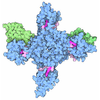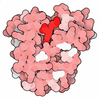Entry Database : EMDB / ID : EMD-38522Title Human KCNQ2-CaM in complex with QO-83 Complex : human KCNQ2-CaM in complex with QO-83Protein or peptide : Potassium voltage-gated channel subfamily KQT member 2Protein or peptide : Calmodulin-1Ligand : ~{N}-[2-azanyl-3-fluoranyl-4-[[4-(trifluoromethyl)phenyl]methylamino]phenyl]-3-cyclopentyl-propanamide / / Function / homology Function Domain/homology Component
/ / / / / / / / / / / / / / / / / / / / / / / / / / / / / / / / / / / / / / / / / / / / / / / / / / / / / / / / / / / / / / / / / / / / / / / / / / / / / / / / / / / / / / / / / / / / / / / / / / / / / / / / / / / / / / / / / / / / / / / / / / / / / / / / / / / / / Biological species Homo sapiens (human)Method / / Resolution : 3.8 Å Zhao YW / Yang ZN / Guo JT / Du XN Funding support Organization Grant number Country National Natural Science Foundation of China (NSFC) U21A20359
Journal : To Be Published Title : Human KCNQ2-CaM in complex with QO-83Authors : Zhao YW History Deposition Dec 31, 2023 - Header (metadata) release Jan 1, 2025 - Map release Jan 1, 2025 - Update Jun 18, 2025 - Current status Jun 18, 2025 Processing site : PDBj / Status : Released
Show all Show less
 Open data
Open data Basic information
Basic information
 Map data
Map data Sample
Sample Keywords
Keywords Function and homology information
Function and homology information Homo sapiens (human)
Homo sapiens (human) Authors
Authors China, 1 items
China, 1 items  Citation
Citation Journal: To Be Published
Journal: To Be Published Structure visualization
Structure visualization Downloads & links
Downloads & links emd_38522.map.gz
emd_38522.map.gz EMDB map data format
EMDB map data format emd-38522-v30.xml
emd-38522-v30.xml emd-38522.xml
emd-38522.xml EMDB header
EMDB header emd_38522.png
emd_38522.png emd-38522.cif.gz
emd-38522.cif.gz emd_38522_half_map_1.map.gz
emd_38522_half_map_1.map.gz emd_38522_half_map_2.map.gz
emd_38522_half_map_2.map.gz http://ftp.pdbj.org/pub/emdb/structures/EMD-38522
http://ftp.pdbj.org/pub/emdb/structures/EMD-38522 ftp://ftp.pdbj.org/pub/emdb/structures/EMD-38522
ftp://ftp.pdbj.org/pub/emdb/structures/EMD-38522 emd_38522_validation.pdf.gz
emd_38522_validation.pdf.gz EMDB validaton report
EMDB validaton report emd_38522_full_validation.pdf.gz
emd_38522_full_validation.pdf.gz emd_38522_validation.xml.gz
emd_38522_validation.xml.gz emd_38522_validation.cif.gz
emd_38522_validation.cif.gz https://ftp.pdbj.org/pub/emdb/validation_reports/EMD-38522
https://ftp.pdbj.org/pub/emdb/validation_reports/EMD-38522 ftp://ftp.pdbj.org/pub/emdb/validation_reports/EMD-38522
ftp://ftp.pdbj.org/pub/emdb/validation_reports/EMD-38522
 F&H Search
F&H Search Links
Links EMDB (EBI/PDBe) /
EMDB (EBI/PDBe) /  EMDataResource
EMDataResource Map
Map Download / File: emd_38522.map.gz / Format: CCP4 / Size: 52.7 MB / Type: IMAGE STORED AS FLOATING POINT NUMBER (4 BYTES)
Download / File: emd_38522.map.gz / Format: CCP4 / Size: 52.7 MB / Type: IMAGE STORED AS FLOATING POINT NUMBER (4 BYTES) Sample components
Sample components Homo sapiens (human)
Homo sapiens (human) Homo sapiens (human)
Homo sapiens (human) Homo sapiens (human)
Homo sapiens (human) Homo sapiens (human)
Homo sapiens (human) Homo sapiens (human)
Homo sapiens (human) Processing
Processing Sample preparation
Sample preparation Electron microscopy
Electron microscopy FIELD EMISSION GUN
FIELD EMISSION GUN
 Movie
Movie Controller
Controller

























 Z (Sec.)
Z (Sec.) Y (Row.)
Y (Row.) X (Col.)
X (Col.)





































